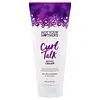What's inside
What's inside
 Key Ingredients
Key Ingredients

No key ingredients
 Benefits
Benefits

 Concerns
Concerns

 Ingredients Side-by-side
Ingredients Side-by-side

Water
Skin ConditioningEmulsifying Wax Nf
Glycerin
HumectantAmodimethicone
Behentrimonium Chloride
PreservativeMethyl Gluceth-20
HumectantHydroxyethylcellulose
Emulsion StabilisingGuar Hydroxypropyltrimonium Chloride
Skin ConditioningPhenoxyethanol
PreservativeCaprylyl Glycol
EmollientCI 42090
Cosmetic ColorantParfum
MaskingLimonene
PerfumingTriticum Vulgare Germ Oil
EmollientCarthamus Tinctorius Seed Oil
MaskingPersea Gratissima Oil
Skin ConditioningAlpha-Isomethyl Ionone
PerfumingCitric Acid
BufferingEthylhexyl Methoxycinnamate
UV AbsorberButylphenyl Methylpropional
PerfumingSilk Amino Acids
HumectantHydrolyzed Wheat Protein/Pvp Crosspolymer
Linalool
PerfumingHexyl Cinnamal
PerfumingAmyl Cinnamal
PerfumingCitronellol
PerfumingBenzyl Salicylate
PerfumingHydroxyisohexyl 3-Cyclohexene Carboxaldehyde
MaskingBenzyl Alcohol
PerfumingSodium Benzoate
MaskingPotassium Sorbate
PreservativeHydroxycitronellal
PerfumingUrtica Dioica Extract
AstringentEquisetum Arvense Leaf Extract
AstringentChamomilla Recutita Flower Extract
MaskingAlthaea Officinalis Root Extract
Skin ConditioningAgave Americana Leaf Extract
Skin ConditioningWater, Emulsifying Wax Nf, Glycerin, Amodimethicone, Behentrimonium Chloride, Methyl Gluceth-20, Hydroxyethylcellulose, Guar Hydroxypropyltrimonium Chloride, Phenoxyethanol, Caprylyl Glycol, CI 42090, Parfum, Limonene, Triticum Vulgare Germ Oil, Carthamus Tinctorius Seed Oil, Persea Gratissima Oil, Alpha-Isomethyl Ionone, Citric Acid, Ethylhexyl Methoxycinnamate, Butylphenyl Methylpropional, Silk Amino Acids, Hydrolyzed Wheat Protein/Pvp Crosspolymer, Linalool, Hexyl Cinnamal, Amyl Cinnamal, Citronellol, Benzyl Salicylate, Hydroxyisohexyl 3-Cyclohexene Carboxaldehyde, Benzyl Alcohol, Sodium Benzoate, Potassium Sorbate, Hydroxycitronellal, Urtica Dioica Extract, Equisetum Arvense Leaf Extract, Chamomilla Recutita Flower Extract, Althaea Officinalis Root Extract, Agave Americana Leaf Extract
Water
Skin ConditioningPolyacrylamide
C13-14 Isoparaffin
EmollientShea Butter Ethyl Esters
EmollientPolyquaternium-10
Lactobacillus/Tomato Fruit Ferment Extract
Skin ConditioningOryza Sativa Extract
AbsorbentKeratin Amino Acids
Skin ConditioningLeuconostoc/Radish Root Ferment Filtrate
AntimicrobialAcyl Coenzyme A Desaturase
Skin ConditioningLaureth-7
EmulsifyingPg-Hydroxyethylcellulose Cocodimonium Chloride
Parfum
MaskingDisodium EDTA
Phenoxyethanol
PreservativeEthylhexylglycerin
Skin ConditioningWater, Polyacrylamide, C13-14 Isoparaffin, Shea Butter Ethyl Esters, Polyquaternium-10, Lactobacillus/Tomato Fruit Ferment Extract, Oryza Sativa Extract, Keratin Amino Acids, Leuconostoc/Radish Root Ferment Filtrate, Acyl Coenzyme A Desaturase, Laureth-7, Pg-Hydroxyethylcellulose Cocodimonium Chloride, Parfum, Disodium EDTA, Phenoxyethanol, Ethylhexylglycerin
 Reviews
Reviews

Ingredients Explained
These ingredients are found in both products.
Ingredients higher up in an ingredient list are typically present in a larger amount.
Parfum is a catch-all term for an ingredient or more that is used to give a scent to products.
Also called "fragrance", this ingredient can be a blend of hundreds of chemicals or plant oils. This means every product with "fragrance" or "parfum" in the ingredients list is a different mixture.
For instance, Habanolide is a proprietary trade name for a specific aroma chemical. When used as a fragrance ingredient in cosmetics, most aroma chemicals fall under the broad labeling category of “FRAGRANCE” or “PARFUM” according to EU and US regulations.
The term 'parfum' or 'fragrance' is not regulated in many countries. In many cases, it is up to the brand to define this term.
For instance, many brands choose to label themselves as "fragrance-free" because they are not using synthetic fragrances. However, their products may still contain ingredients such as essential oils that are considered a fragrance by INCI standards.
One example is Calendula flower extract. Calendula is an essential oil that still imparts a scent or 'fragrance'.
Depending on the blend, the ingredients in the mixture can cause allergies and sensitivities on the skin. Some ingredients that are known EU allergens include linalool and citronellol.
Parfum can also be used to mask or cover an unpleasant scent.
The bottom line is: not all fragrances/parfum/ingredients are created equally. If you are worried about fragrances, we recommend taking a closer look at an ingredient. And of course, we always recommend speaking with a professional.
Learn more about ParfumPhenoxyethanol is a preservative that has germicide, antimicrobial, and aromatic properties. Studies show that phenoxyethanol can prevent microbial growth. By itself, it has a scent that is similar to that of a rose.
It's often used in formulations along with Caprylyl Glycol to preserve the shelf life of products.
Water. It's the most common cosmetic ingredient of all. You'll usually see it at the top of ingredient lists, meaning that it makes up the largest part of the product.
So why is it so popular? Water most often acts as a solvent - this means that it helps dissolve other ingredients into the formulation.
You'll also recognize water as that liquid we all need to stay alive. If you see this, drink a glass of water. Stay hydrated!
Learn more about Water